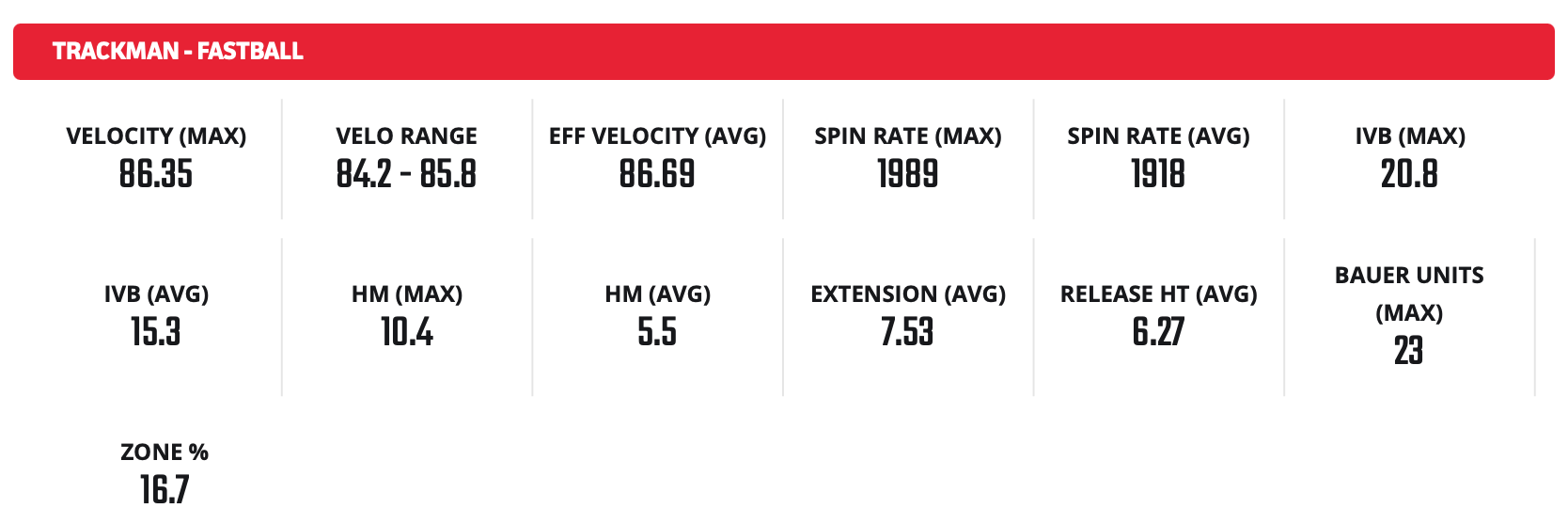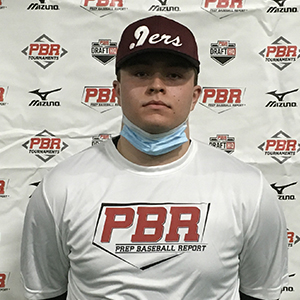Trackman Traits - Pitching: 2023 RHP Anthony Holtje (DePaul Catholic)
May 21, 2021
Welcome back to Trackman Traits. In this piece we will be dissecting the numbers the Trackman produces and the effect they can have on a pitcher's approach. Below there will be definitions of each category that we believe to be the most important for a young arm to keep in mind as well as breaking down an arm and giving suggestions on how they can improve their game. Keep in mind, in some categories it is better to be further away from average even if the numbers are wavering on below average.
FASTBALL VELOCITY
Fastball velocity doesn't go much deeper than just looking at the numbers and comparing them to the graphic below! Fastball velocity complements just about all of the other metrics that are measured. If you throw hard, it makes all your other pitches/metrics even better.
FASTBALL SPIN RATE
Spin rate is a measurement that if you are below average or above average, you can pitch with more room for error. On the other hand, if you are average you should try to throw in the bottom half of the zone with exceptional command. High spin fastballs profile as one that is frequently described as having "late life". Low spin fastballs tend to profile as a fastball that has heavy feel to it. Pitch movement is still dependent on spin direction of the pitch but Trackman does not have that metric displayed on profiles.
BAUER UNITS
Bauer Units are an easier way of determining how useful the spin numbers are compared to the velocity. We can calculate this metric by taking average spin rate and dividing it by average velocity. Bauer Units are useful because we can have a case of two pitchers with the same spin numbers, ex. 2200 RPM, but one pitcher throws 90 MPH and the other throws 83 MPH. The pitcher throwing 90 MPH with 2200 spin is not as impressive as the pitcher throwing 83 MPH with the same spin. Typically, we would tell the harder throwing pitcher to throw up in the zone purely off his velocity and his high spin, but because his Bauer Units would equate to around 24 that would be only 1 unit off of average (23), therefore he would want to hammer the bottom of the zone. On the other side, the pitcher throwing 83 MPH has a Bauer Unit measurement of 26 which is incredibly impressive. This would allow him to throw up in the zone even though his velocity is not blow away type numbers because he produces above average spin with that slated velocity.
FASTBALL INDUCED VERTICAL BREAK
As far as deception and importance goes, fast induced vertical break (IVB) may be the most important. Induced vertical break is not what is sounds. IVB simply means the pitch is "breaking" upward from the average level a pitch falls from release to home plate. This is a stat that you want to stay away from being average at. Fortunately, this can be tweaked slightly depending on release height. To put it simply, the higher number = more "rise" the pitch has compared to average. Lower number = more depth the pitch has to it.
VERTICAL APPROACH ANGLE
Vertical Approach Angle (VAA) is essentially how steep or shallow the ball is entering the strike zone. The average entry into the zone is around -5.5 degrees for the Division 1 college level. Anything below or above that number is considered an outlier and would be ideal because it is not what the hitter is used to seeing. A VAA of -4.5 degrees would be considered a shallow entry, this, with some other variables mixed in (IVB, velocity, release height), allow for success up in the zone due to the "ride" or even sometimes "rising" effect. A VAA of -6 degrees would be considered a steep entry. This is the type of ball that has a lot of success in the bottom of the zone (including the same variables mentioned previously) because it feels like the pitcher is throwing it off Mt Everest. With the perfect combination of low IVB and high release it could be a very steep entry that would be hard to hit.

Anthony Holtje
Class of 2023 / RHP
Player Information
-
Graduating Class: 2023
-
Primary Position: RHPSecondary Position: 3B
-
High School: DePaul CatholicState: NJ
- Summer Team: Complete Performance Baseball Academy
-
Height: 6-1Weight: 210lbs
- Bat/Throw: R/R
Videos
(3/20/21)


Fastball Breakdown
Velocity: Holtje can run his fastball up into the mid 80's with well above average arm speed getting downhill on the ball. Sitting in the low-mid 80's would put him in the top 25% of high school arms for raw velocity. Typically at this young of an age, this type of velocity is just above and beyond what a typical 16 year old kid is throwing. What the goal of this article sets out to accomplish is to give these arms more of a feel for where in the zone specifically they can expect to see the most success as far as weak contact and swings and misses. We want to dive deep past just "blowing it by hitters" and really help develop an approach on the bump.
Spin Rate: Holtje comes in on average with 1918 RPM and that would set him just on the verge of the top 50% for high school pitchers. As we know, spin just creates a ceiling for the movement of a pitch. Higher spin = high probability of movement in whatever direction the ball is spinning. On the other end of the spectrum, lower spin can also create movement for fastballs but in the downward direction. All of this movement does depend on the orientation of the ball and how it is spinning on its way to home plate.
Bauer Units: Bauer Units give us a good idea of the "expected" spin Holtje produces for the velocity he is throwing. With a Bauer Unit measurement of 23, Holtje's spin is right on pace with where a typical 86 MPH fastball should be. This just means that he is producing about the spin you would expect for a fastball at 86 MPH. Again, this measurement is not something that you want to be super concerned with. It is more valuable just to gauge you spin relative to your velocity.
Induced Vertical Break: Holtje has an average IVB of 15 inches. This would put him around the top 75% on the chart for high school arms. Holtje has the potential to be a top of the zone pitcher if he can manipulate the ball better and get higher spin. The velocity is there, but he just needs something to set him apart from the pack and make his fastball next level. With minimal horizontal movement, Holtje creates a pretty straight fastball with some depth to it. What does plat for Holtje is his release height and extension. He is getting so far down the mound and releasing from such a tall point that his fastball is barreling down on the hitter and giving it more of a heavy feel with this type of delivery. With this, Holtje does present some power to the bottom part of the zone. The game plan should be to continue pounding the bottom half of the zone with intent.

Recent Trackman Traits
- NJ Trackman Traits- Hitting: 2023 1B/3B Allen Hernandez (Florida Gulf Coast commit) 5/28/21
- NJ Trackman Traits - Pitching: 2024 RHP Ryan Lynch (Moorestown) 5/28/21
- NJ Trackman Traits - Pitching: 2024 RHP Gavin Soares (Northern Highlands) 5/26/21
- NJ Trackman Traits- Hitting: 2022 3B/SS Jarrett Pokrovsky (Penn commit) 5/25/21
- NJ Trackman Traits - Pitching: 2023 RHP Anthony Holtje (DePaul Catholic) 5/21/21
- NJ Trackman Traits- Hitting: 2022 C Chris Smith (Scotch Plains-Fanwood) 5/20/21
- NJ Trackman Traits - Pitching: 2021 RHP Joseph Carrea (Villanova Commit) 5/19/21
- NJ Trackman Traits- Hitting: 2023 3B/1B Ryan Jaros (Georgia Tech commit) 5/18/21
- NJ Trackman Traits - Pitching: 2023 RHP Nick Sulpizio (Bishop Eustace) 5/14/21
- NJ Trackman Traits- Hitting: 2021 3B/OF Aries Samek (Clemson commit) 5/13/21
- NJ Trackman Traits- Pitching: 2023 RHP Anthony Marano (DePaul Catholic) 5/11/21
- NJ Trackman Traits - Pitching: 2023 RHP Duke McCarron (Maryland Commit) 5/08/21
- NJ Trackman Traits- Hitting: 2022 3B/SS Matthew McIntire (Williamstown) 5/06/21
- NJ Trackman Traits - Pitching: 2023 RHP Griffin Seibel (Glen Ridge) 5/05/21
- NJ Trackman Traits- Hitting: 2023 C Billy Mulholland (Pascack Hills) 5/04/21


Scouting Report
6-foot-1, 215-pound sturdy frame. Projectable on the mound. Showed a quick arm action with a high ¾ arm angle. Used easy effort in his delivery. Tall balance point with even shoulders. Lands square with an athletic finish. Produced a fastball that came in at 81-84 mph and topped out at 84 mph; had running action and commanded it well. His 12/6 curveball (68-70) had late, downer action. Shows arm side command and fading action on his changeup (70-71).
Holtje has a 6-foot, 220-pound solid frame. On the mound, he showed some looseness to his arm action a high ¾ angle. Clocked sitting at 81-83 mph with a max of 84 mph. Had a 12/6 curveball (67-68) that showed consistent command. His changeup( 72-73) showed fading action for strikes as well. Slow, methodical start to delivery into a strong balance point. Uphill shoulders at first foot strikes. Lands square. Finishes over lead leg with extension. One of the top arms from the event.